This article is focused on constellations visible in the Southern Hemisphere, specifically New Zealand in July 2019.
As we move on from the Winter Solstice in the Southern Hemisphere, we say farewell to some constellations and welcome others. Read on to find out what celestial objects you can observe this month in New Zealand!
Planets
At the beginning of the month, Jupiter is visible for the entire night on the southeastern to southwestern horizon, and is best viewed at around 10.45pm. By the middle of the month, Jupiter is visible for most of the night, is best viewed at around 9.30pm and sets at around 5am. At the end of the month, it is still visible for most of the night, but is best viewed at around 8.45pm and sets at around 4am. Look for Jupiter’s 4 moons through binoculars/telescopes.
At the start of the month, Saturn is visible for the entire night on the southeastern to southwestern horizon and is best viewed around 1am. By the middle of the month, Saturn is still visible the entire night and is best viewed at around 12am. By the end of the month, Saturn is visible the entire night and is best viewed around 11pm. Look for Saturn’s rings through binoculars/telescopes.
Uranus and Neptune can both be observed in the hours before sunrise. Uranus rises at around 2.30am at the beginning of the month, and around 12.45am by the end of the month on the northeast horizon, and so is best seen just before sunrise.
Neptune rises at around 10.45pm at the beginning of the month and 8.45pm by the end of the month on the eastern horizon. It is best viewed at around 5am at the beginning of the month, and 3am by the end of the month.
Mercury and Mars are low on the horizon this month, but a glimpse can be spotted around sunset on the northwest horizon. Venus is quite close to the sun, and rises during the day, so is difficult to find. However, a glimpse may be seen around sunset and sunrise on the northwest and northeast horizons respectively.
Moon
At the start of the month, on 3rd July is the New Moon with 0.1% illumination. The moon rises at 7.38am on the northeastern horizon and sets at 5.37pm on the northwestern horizon.
On the 9th of July is a waxing first quarter moon with 48% illumination. It rises at 12.04pm on the eastern horizon and sets just after midnight on the western horizon.
The middle of the month, 17th July brings a full moon with 99.8% illumination. It rises at 5.35pm on the southeastern horizon and sets at 8.17am on the southwestern horizon the next day, meaning the night sky will be brightly-lit.
In addition, there is a partial lunar eclipse on the 17th of July, starting at 6.43am local time (NZST), when the penumbral eclipse will begin. The maximum occurs at 7.58am, however the moon will be very close to the horizon and the eclipse would best be seen from a high vantage point. The partial eclipse begins at 8.01am, where the moon starts getting red. After this, the moon will be very faintly visible as it sets at 8.17pm.
The 25th of July brings a waning last quarter moon with 53% illumination, and the moon rises at 12.09am on the eastern horizon and sets at 11.52am on the western horizon. It will also leave the night sky fairly bright.
At the end of the month, we get a 2% illuminated (almost) new moon, rising at 6.20am on the northeastern horizon and setting at 4.22pm on the northwestern horizon, leaving nice, dark skies for observing winter night sky targets.
Constellations
Scorpius
Scorpius the Scorpion has some stunning deep sky targets. At this time of the year, it is high in the sky, almost overhead, and can be found in the Milky Way band running across the sky. It can easily be found due to its distinctive hook-like tail, and its bright-red star, Antares.
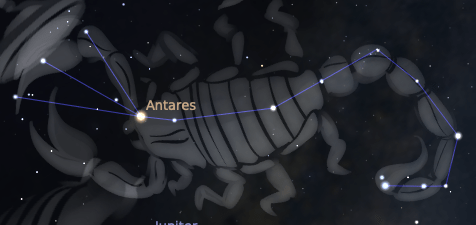
One of the best targets in Scorpius is M4, or the Crab Globular Cluster, a stunning globular cluster 7,176 light years away, and easily seen through binoculars. Its age is an estimated 12 billion years.

M80 is another globular cluster located in Scorpius. It is 32,620 light years away and is faint, thus best seen through a telescope.
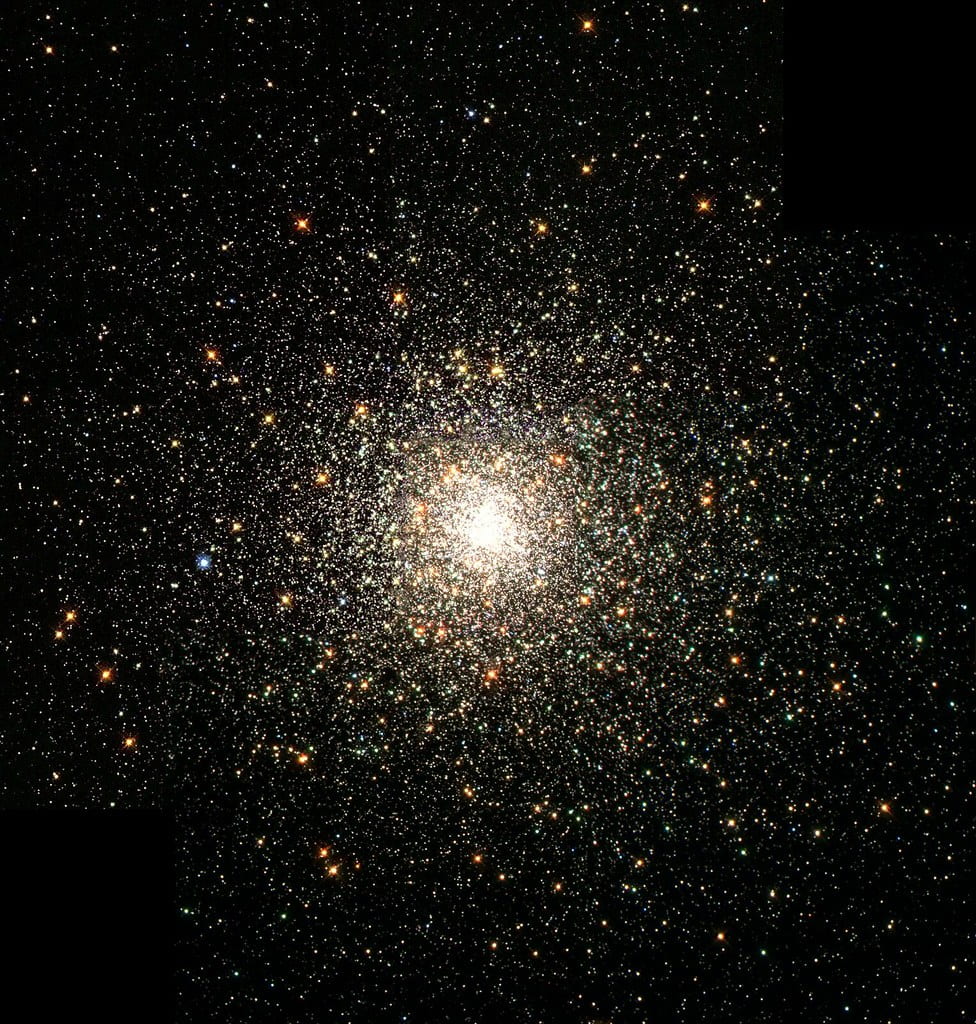
M6, the Butterfly Cluster is a spectacular open cluster, located 1,601 light years away. Another open cluster in Scorpius is M7, Ptolemy’s Cluster, which is located 978 light years away. Both can be seen as fuzzy patches to the naked eye, and are viewed best through binoculars or telescopes.
Antares, or ɑ Scorpii, is the brightest star in Scorpius, with an extincted apparent magnitude of 1.21. It is a pulsating variable star and is a binary star system. It’s located 553 light years away and is of spectral type M1, a red supergiant star.
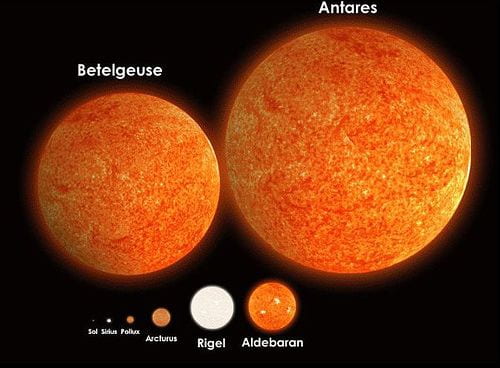
Sagittarius
Sagittarius the Archer is also a magnificent winter constellation in the Southern Hemisphere. It has many wonderful deep-sky targets. The constellation can be found above the eastern-southeastern horizon. The Milky Way band runs through it.

M8, the Lagoon Nebula is an HII region located 4,077 light years away. It is a faint fuzzy, meaning it can be seen by the naked eye, but the experience is enhanced through binoculars or telescopes. Another faint fuzzy is M17, the Omega or Swan Nebula, which is a cluster associated with nebulosity. It’s located 5,499 light years away and is best viewed through a telescope. M20, the Trifid Nebula is another cluster associated with nebulosity, located 5,219 light years away.
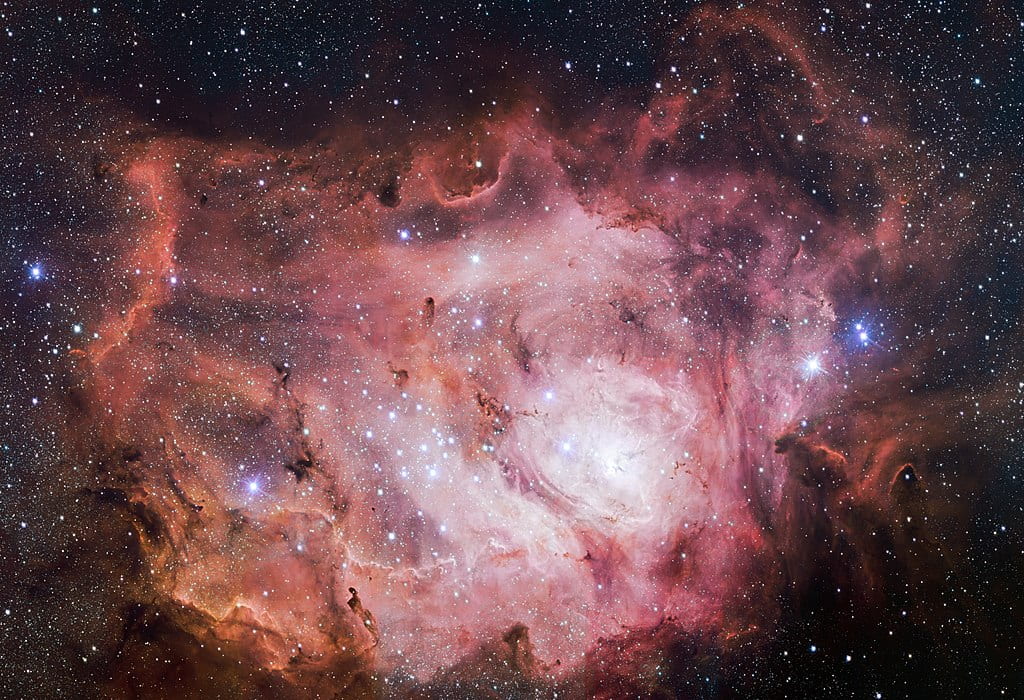
M21, Webb’s Cross is an open cluster located 4,240 light years away. The Great Sagittarius Cluster, M22 is a globular cluster located about 9,786 light years away, estimated to be 12 billion years old. M23 is another open cluster at a distance of 2,149 light years away.

M24, the Small Sagittarius Star Cloud is a cloud of gas with a star cluster within. It’s located at a distance of 10,014 light years, and is angled at a 90° orientation. M25 is another open star cluster located 1,999 light years away, and is visible through binoculars.
M28 and M54 are two globular clusters located 17,941 and 87,422 light years away respectively. They are both rather far away, and are thus best viewed through a telescope.
M55 is the Specter Cluster, a globular cluster located 17,614 light years away. M69, M70 and M75 are also globular clusters located 29,684, 29,358 and 67,523 light years away, respectively. They are best viewed through telescopes as they are all 9th-magnitude in brightness, i.e. quite faint.
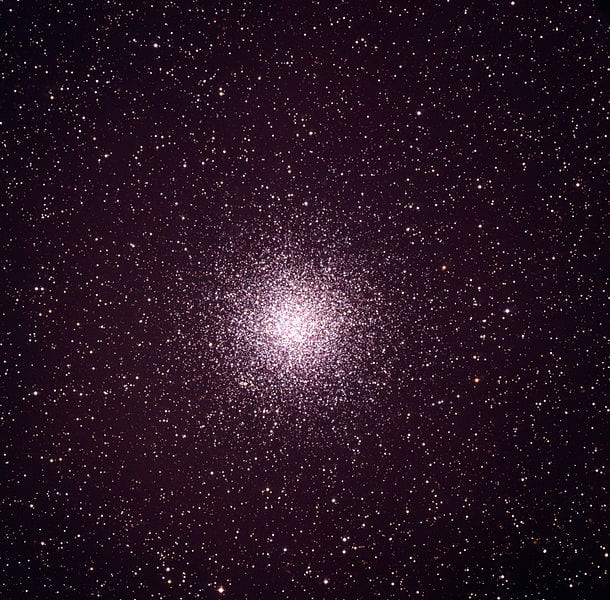
Ara
Ara the Altar is a small Southern Hemisphere constellation, lying south of the tail of Scorpius. It can be found on the east-south horizon, high up in the sky with the Milky Way running through it. It doesn’t have many deep sky objects, save NGC 6397. It’s a globular cluster located 7,176 light years away, and is one of the closest globular clusters to Earth.

The brightest star in Ara, ɑ Ara, may make for some interesting viewing. ɑ Ara is a variable double star of spectral type B2. It is located 267 light years away and its apparent extincted magnitude is 2.96, thus easily visible through binoculars. It has a period of 0.98 days.
Corona Australis
Corona Australis, the Southern Crown is a small Southern Hemisphere constellation, and is a smaller version of Corona Borealis, the Northern Crown. It can be found beneath Sagittarius and beside the tail of Scorpius. The Milky Way runs through it, and thus Corona Australis can be found high up on the east-southeastern horizon.

Corona Australis doesn’t have many interesting targets, but one is NGC 6541. Also known as the Cacciatore Cluster, it’s a globular cluster located 22,834 light years away, and is best viewed through a telescope.
Ophiuchus
Ophiuchus the Serpent Bearer is a large constellation near Scorpius and Sagittarius. It’s located on the northeastern-eastern horizon. The planet Jupiter is currently in Ophiuchus. It contains a few decent globular clusters that are all between 6th and 9th apparent extincted magnitude, therefore best viewed with a telescope.

M10 and M12 are globular clusters 14,352 and 15,657 light years away respectively. They are sometimes visible in the same field of view, depending on the telescope used.
M9 and M14 are diffuse globular clusters located 25,769 and 30,336 light years away respectively.
M19 is an oblate globular cluster located 28,705 light years away.

M62, the Flickering Globular Cluster, and M107, the Crucifix Cluster are more diffuse globular clusters located 22,181 and 20,875 light years away respectively.

Scutum
Scutum the Shield is a small constellation on the northeastern-eastern horizon. It can be found between Ophiuchus and Sagittarius. Scutum doesn’t have many interesting targets.

M11, or the Wild Duck Cluster is an open cluster located 6,197 light years away. It looks great through a telescope, where the v-shape of the stars looks like ducks in flight formation. M26 is another open cluster, but faint. It is located 5,003 light years away.

Serpens
Serpens the Serpent is an interesting constellation because it’s split into two parts. Serpens Cauda (head of the serpent) and Serpens Caput (tail of the serpent) are on either side of Ophiuchus.
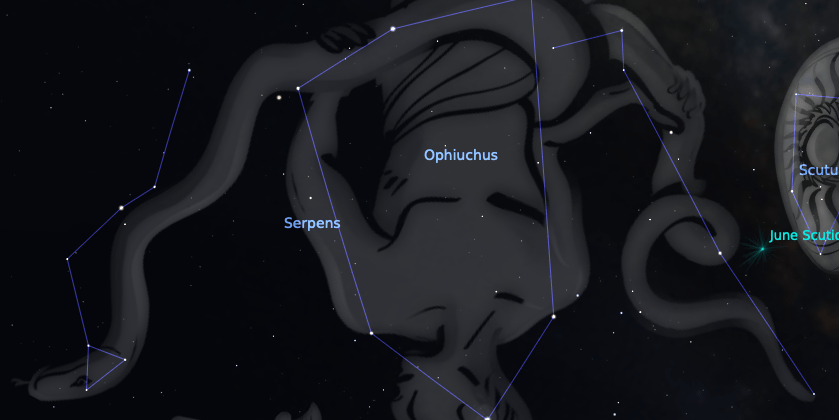
M16 is an open cluster of stars located in front of the Eagle Nebula, and can be found in Serpens Cauda. The Eagle Nebula is famous for its Pillars of Creation structure, tall columns of interstellar gas and dust. M16 is located 7,000 light years away.
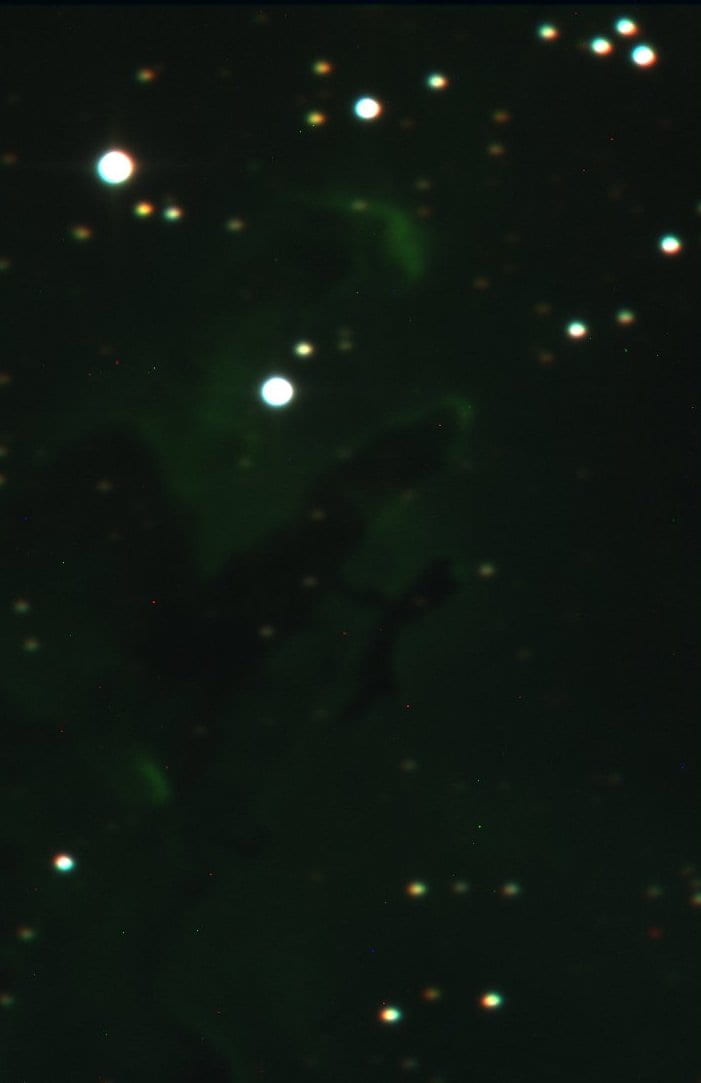
M5, the Rose Cluster is a globular cluster in Serpens Caput. It is located 24,465 light years away. The brightest star in Serpens, ɑ Ser, or Unukalhai, may make for some interesting observing. Unukalhai is a double star of spectral type K2 and is located 73.9 light years away.
Centaurus
Centaurus the Centaur is located high in middle of the Milky Way. It contains some interesting objects.
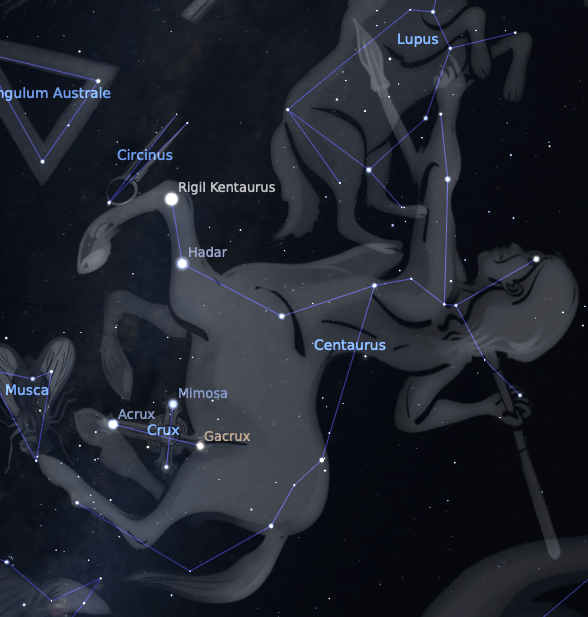
One of the best targets in Centaurus is the globular cluster, Omega (ω) Centauri. A stunning globular cluster, it can be seen through binoculars. It is the largest globular cluster which can be seen by the naked eye and is 11.5 billion years old and approximately 15,788 light years away.
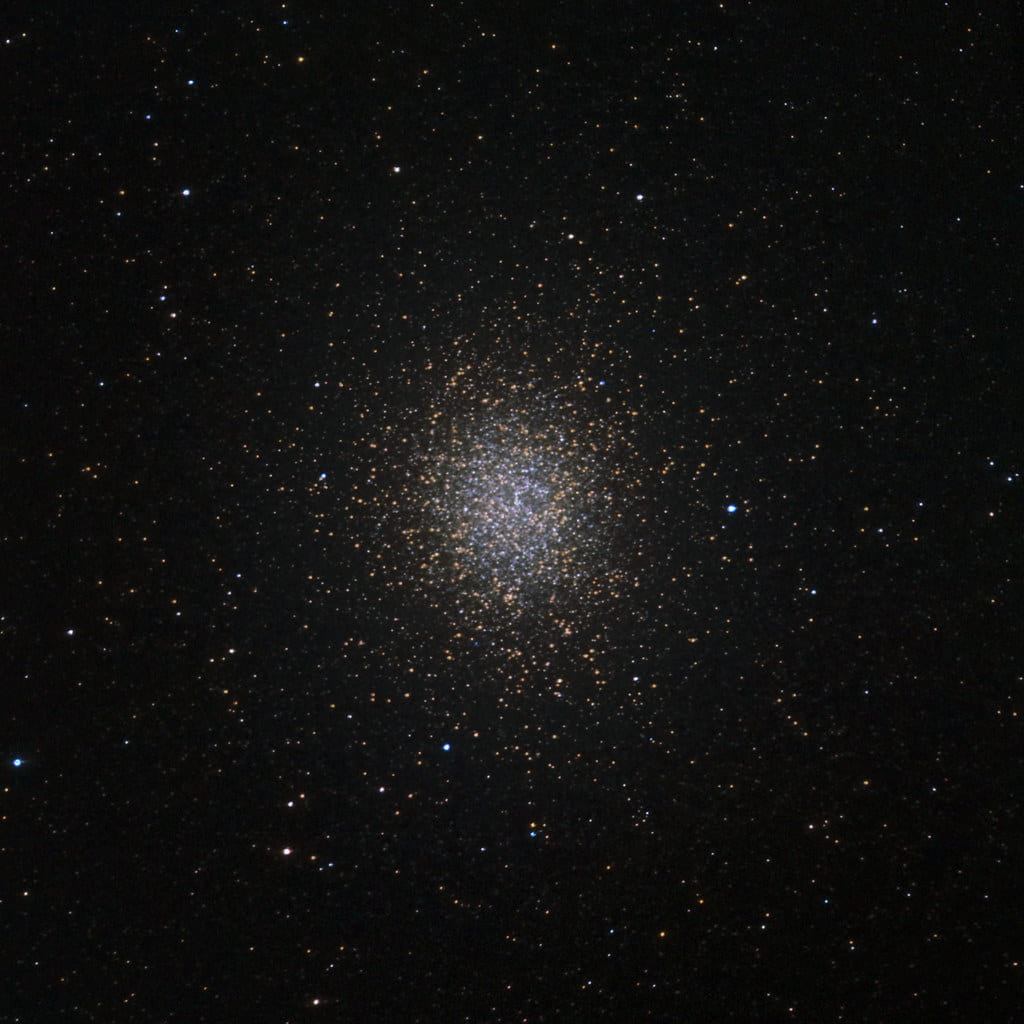
Another interesting target in Centaurus is the Rich Man’s Jewel Box, NGC 3766, which is an open cluster of approximately 50-60 stars and is located at a distance of roughly 5,692 light years away.
Yet another perhaps hard-to-spot target is NGC 3918, the Little Blue Planetary Nebula. It appears as a little blue dot, resembling a planet, if a large enough telescope is used.

Carina
Carina the Keel used to be part of the larger constellation Argo Navis. The other parts of Argo Navis include Vela the Sails and Puppis the Poop Deck. Carina has a few interesting targets, and is visible on the southern-southwestern horizon. The Milky Way runs through Carina.

One of the most famous southern hemisphere targets in Carina is NGC 3372, the Eta Carina Nebula, a diffuse cloud of HII gas surrounding the hypergiant star Eta Carinae. It is located approximately 6,524 light years away.
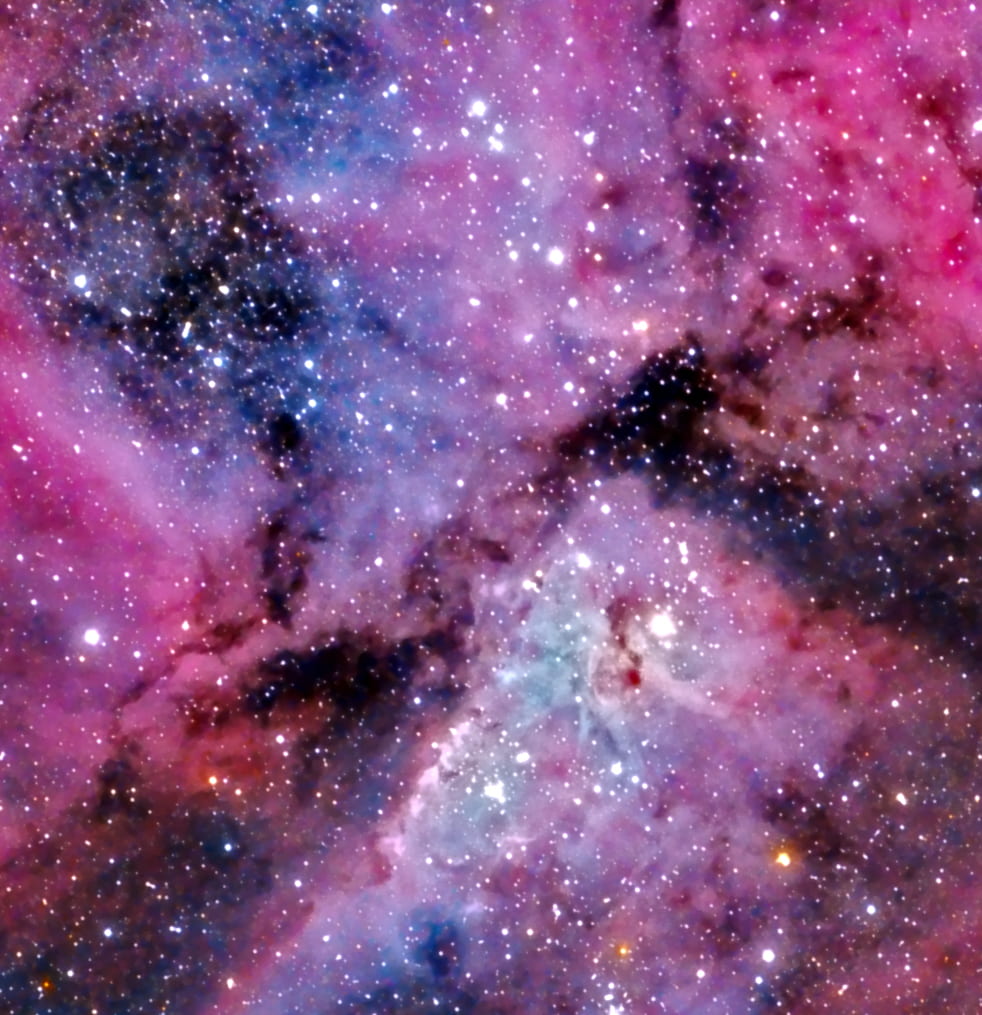
The Wishing Well Cluster, NGC 3532, is also a beautiful open star cluster nearby the Eta Carina Nebula, and looks especially great through a telescope, as it is an approximate distance of 1,600 lights years away. Another star cluster, the Diamond Cluster, NGC 2516, is a naked-eye open cluster with two red stars in the middle, and is closer to us at roughly 1,100 light years.
The Southern Pleiades is the Southern Hemisphere counterpart to The Pleaides, and can be seen with the naked eye as a fuzzy patch. It is actually a small open cluster, enhanced by a telescope.
The brightest star in Carina, ɑ Car, or Canopus is the second-brightest star in the night sky, after Sirius in Canis Major. Canopus is a type A9 star with an apparent magnitude of -0.29. It is located 309 light years away.
Vela
Vela the Sails is another part of the old constellation Argo Navis. Vela doesn’t have many decent faint fuzzies, except the Southern Ring Nebula, NGC 3132, which is a planetary nebula that is best viewed through a telescope. It is located at a distance of roughly 4,199 light years away.
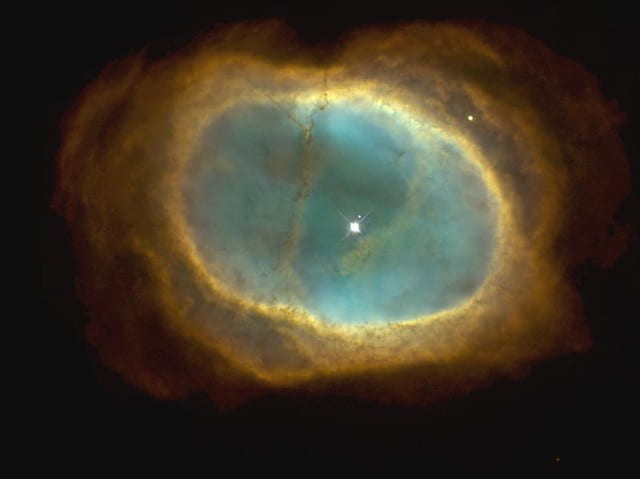
Corvus
Corvus the Crow is a small and otherwise unremarkable constellation, located high on the western-northwestern horizon. The infamous colliding Antennae galaxies can be found in Corvus. They are two barred spiral galaxies colliding together 72 million light years away.


Crater
Crater the Cup is another small constellation located next to Corvus. It is located high on the western-northwestern horizon and contains two faint galaxies, both close enough to each other that they can be seen in the same field of view using a telescope. One of the galaxies, NGC 3511, is an active spiral galaxy located 56 million light years away, and the other galaxy NGC 3513 is a barred spiral galaxy located 55 million light years away.

Leo
Leo the Lion has many interesting objects to observe using a telescope. It is located above the north-western horizon.

The Leo Triplet contains three galaxies, M65, M66 and NGC 3628, which are visible in the same field of view. They are all active galaxies and are each located a few million years away.
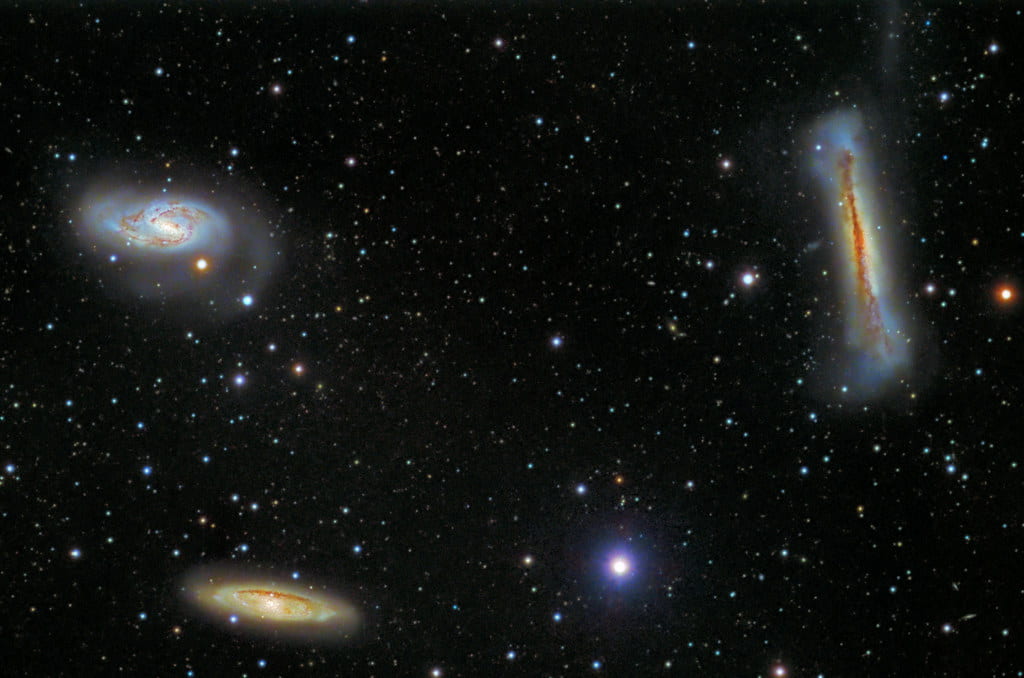
Another pair of galaxies, M95 and M96 are also visible in their own same field of view. They are both active barred spiral galaxies located roughly 30-32 million light years away.
The brightest star in Leo, ɑ Leo or Regulus is the 21st-brightest star in the night sky. It is an intriguing object, since it is actually a quadruple star system. The brightest of these, Regulus A is a type-B star. The system is located approximately 79 light years away.
Virgo
Virgo the Virgin is the second-largest constellation in the sky and contains some interesting targets. It is located on the northwestern-northern horizon and can be found near Crater and Corvus.

One of the most well-known objects in Virgo is the Sombrero Galaxy, M104. It is an active spiral galaxy located about 29 million light years away.

The Virgo Cluster is a cluster of about 1500 galaxies and is located at a distance of approximately 65 million light years to us. It is considered to be the centre of the Virgo Supercluster, which we (the Milky Way) are located at the edges of. It is best observed through a telescope.
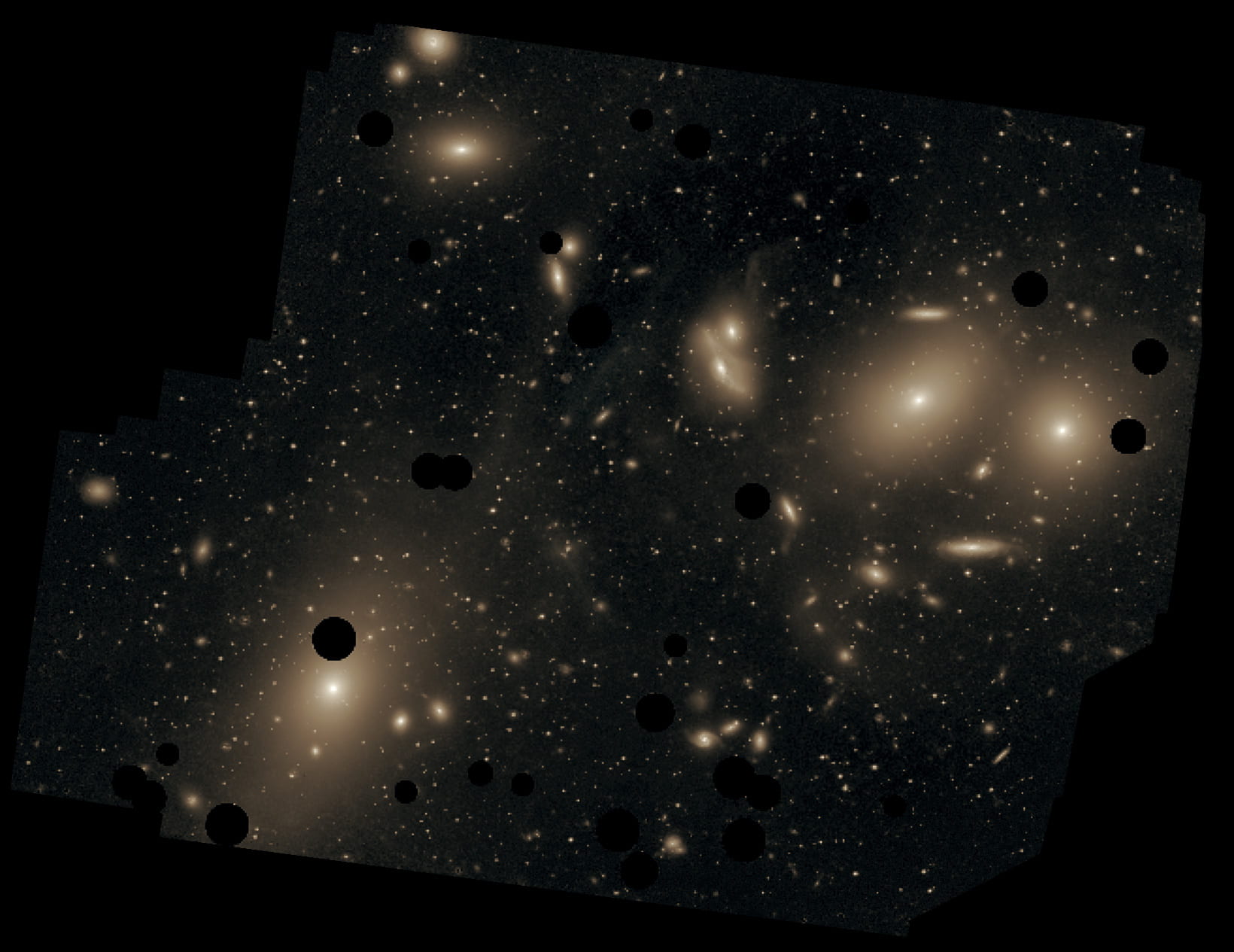
The brightest star in Virgo is ɑ Vir, or Spica. It is a variable double star with a period of 4.01 days. It has apparent magnitude 1.11, is of spectral type B1, and is located 249 light years away.
Coma Berenices
Coma Berenices means ‘Bernices’ Hair’ in Latin and refers to an Egyptian queen’s hair. It is located on the northwestern-northern horizon and contains some interesting faint fuzzies.
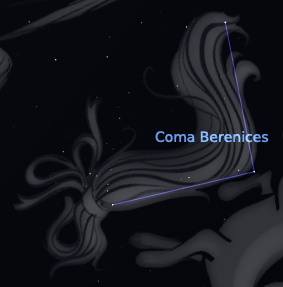
M53 is a globular cluster located 58,716 light years away. M64, or the Black Eye Galaxy, is an active spiral galaxy located 24 million light years away.

M85 is a lenticular galaxy located 60 million light years away. M88 is an active spiral galaxy at a distance of 47 million light years. M91 is a barred spiral galaxy 61.9 million light years away. M98 is another active barred spiral galaxy located 113 million light years away. All of these galaxies are 10th and 13th magnitudes and are very faint.
M99, the Virgo Cluster Pinwheel, is an active spiral galaxy located 50 million light years away. M100, the Blowdryer Galaxy is another active barred spiral galaxy located 54.9 million light years away.

Hydra
Hydra the Water Snake is a large constellation stretching the sky. It has some interesting star clusters and galaxies.

M48, the Beehive Cluster is an open cluster, which can be found near Hydra’s tongue. It can be seen by the naked eye, and is about 1500 light years away. A globular cluster, M68, can be found near the tail of Hydra. It is 33,598 light years away.
The Southern Pinwheel Galaxy, M83, can be found near the tail of Hydra. It is an active barred spiral galaxy located about 15 million years away.
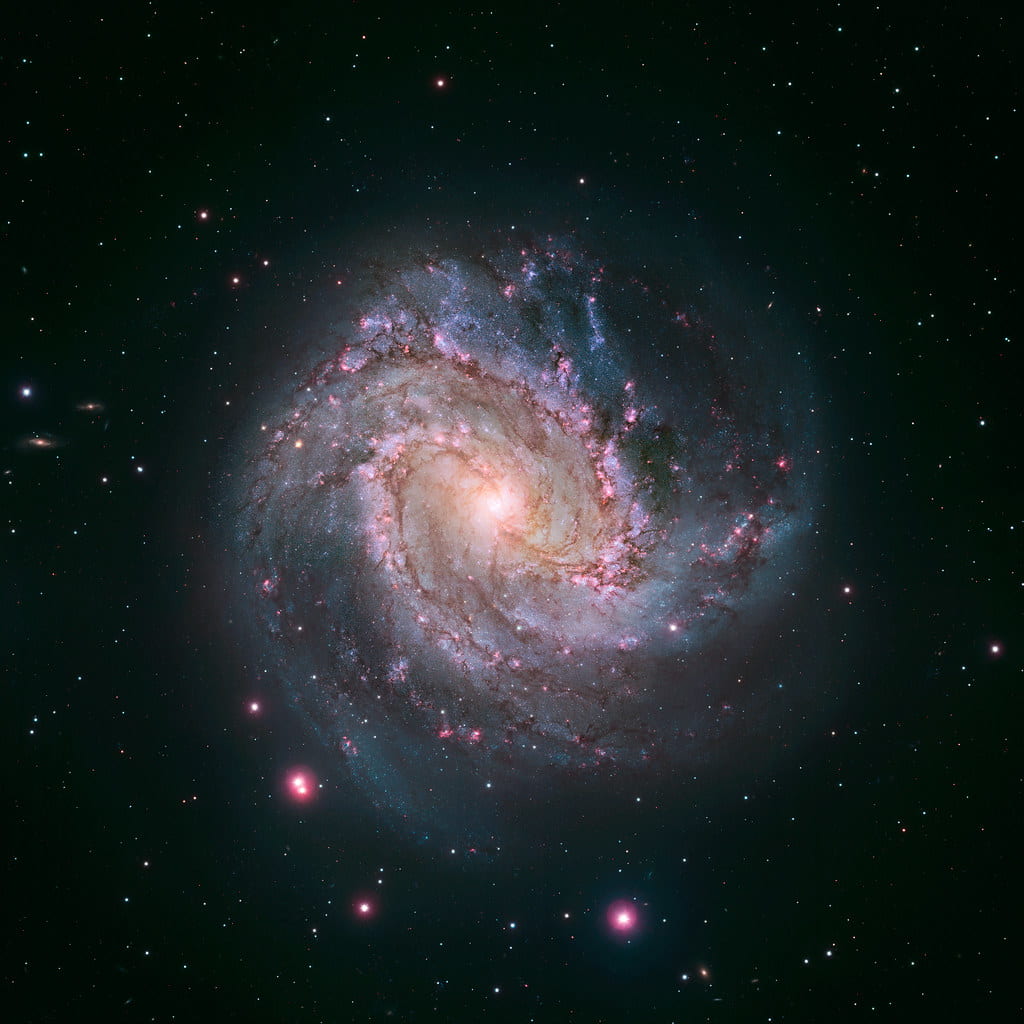
Lupus
Lupus the Wolf is a Southern Hemisphere constellation. One object to observe is NGC 5822, an open star cluster. It is best viewed through binoculars.
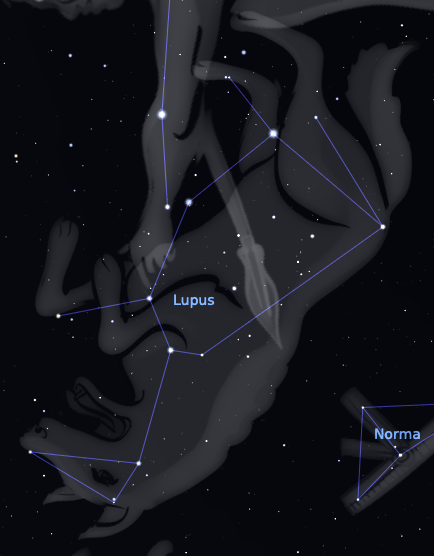
The brightest star in Lupus is ɑ Lup, or Alphard. It is a double pulsating variable star with a period of 0.26 days. It has an apparent magnitude of 2.32, is of spectral type B2 and is located 464 light years away.
Sextans
Sextans the Sextant is a faint and small constellation. One object of interest is NGC 3115, the Spindle Galaxy. It is a lenticular galaxy located 33 million light years away.
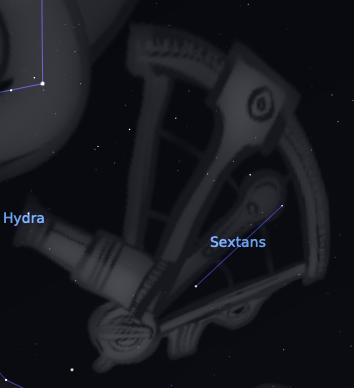
Circumpolar Constellations
Crux
Crux the Southern Cross is one of the most prominent southern constellations despite its small size, and features in many Southern Pacific countries’ flags, including New Zealand. It is located high on the southwestern horizon.
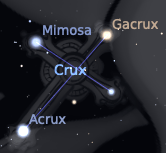
One of the most dazzling objects in Crux is the Jewel Box Cluster, NGC 4755, an open cluster of stars. It is located approximately 11,200 light years away. Read more about it here.
Another interesting feature in Crux is the Coalsack Nebula, a giant cloud of gas and dust obscuring everything behind it. It is visible to the naked eye and is located 600 light years away.
The brightest star in Crux, ɑ Cru, or Acrux is a double star of apparent magnitude 1.39, spectral type B0 and is located 320.7 light years away. The second-brightest star in Crux is β Cru, or Mimosa. It is a double pulsating variable star located 352 light years away with a period of 0.23 days. Mimosa is of spectral type B1 and currently has an apparent magnitude of 1.39, the same as Acrux.
Dorado
Dorado the Swordfish is a small constellation on the southern-southwestern horizon. It is most easily recognisable due to the presence of the Large Magellanic Cloud nearby.
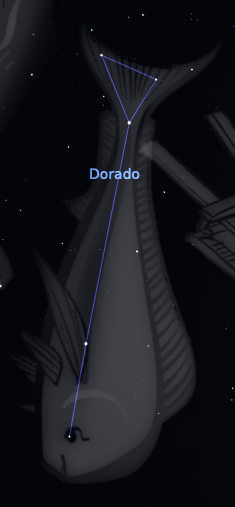
The Tarantula Nebula, NGC 2070 is a naked-eye nebula containing many stars. It is located 170,015 light years away.
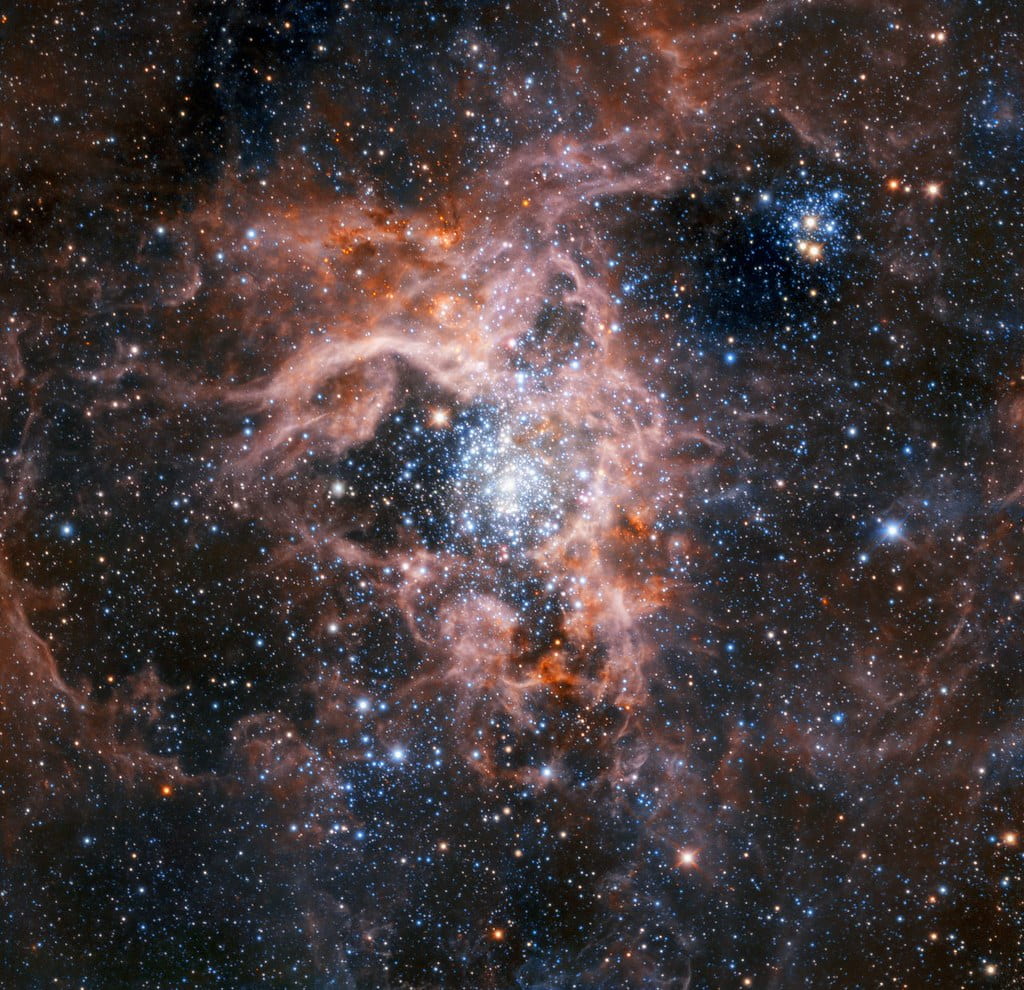
The Large Magellanic Cloud appears as a naked-eye large fuzzy patch in the sky, however is actually a dwarf galaxy, located approximately 163,000 light years away.
Tucana
Tucana the Toucan is another small constellation, and contains the Small Magellanic Cloud.

The second-best globular cluster in the sky after Omega Centauri is 47 Tucanae, NGC 104. It is looks impressive through binoculars or a telescope, but is visible to the naked eye. It is located 15,298 light years away.
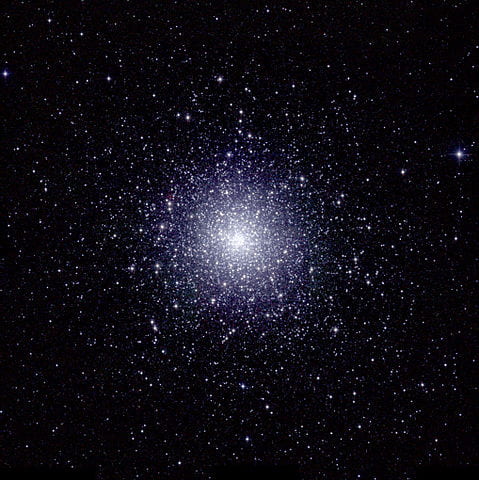
The Small Magellanic Cloud is also another dwarf galaxy located 200,000 light years away.
Pavo
Pavo the Peacock is a small constellation on the southeastern-southern horizon. It contains NGC 6752, the Pavo Globular Cluster, located 13,048 light years away. The brightest star in Pavo, ɑ Pav is a double star at a distance of 178.8 light years. It has an apparent magnitude of 2.14 and is of spectral type B3.
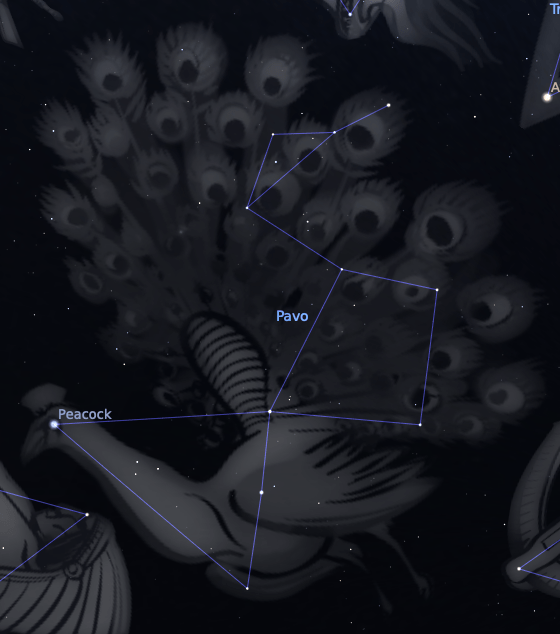
It is a wonderful time of the year to go out and observe, since it is winter and we have many clear nights, but also because there are many beautiful night-sky targets to observe. The possibilities are nearly endless! So head out to your local observatory now and go observing!
If you liked my article, please like and share! Also feel free to check out my website, https://www.aayushiverma.com/, where I also post my articles and other things!
This article was originally published on my WordPress blog ‘The Wonders of the Cosmos’, here.













